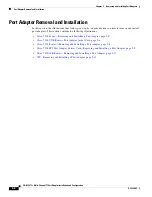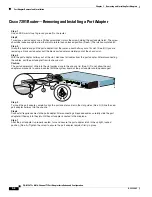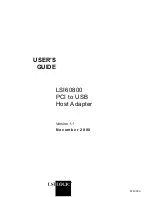
4-3
PA-MC-2T3+ Multi-Channel T3 Port Adapter Installation and Configuration
OL-3526-05
Chapter 4 Configuring Unchannelized mode for the Cisco PA-MC-2T3+
Configuring an Unchannelized T3 Link
The following example is for a PA-MC-2T3+ in port adapter slot 1 of a VIP in a Cisco 7500 series router.
Router(config-controller)#
end
Router#
show controller T3 1/1/0
T3 1/1/0 is administratively down.
Router#
show controller T3 1/1/1
T3 1/1/1 is administratively down.
Step 5
Save the shutdown configuration to nonvolatile memory.
Router#
copy running-config startup-config
Step 6
Replace the port adapter in the slot. See the
“Port Adapter Removal and Installation” section on page 3-4
for more information.
Step 7
Re enable the port adapter by doing the following:
a.
Repeat Step 3 to renewable an interface but substitute the
no shutdown
command for the
shutdown
command.
b.
Repeat Step 4 to verify that the interfaces are in the correct state and no longer shut down. Use the
show controller T3
command.
c.
Repeat Step 5 to write the new configuration to memory.
Use the
copy running-config startup-config
command.
For complete descriptions of software configuration commands, refer to the publications listed in the
“Related Documentation” section on page viii
Configuring an Unchannelized T3 Link
If you installed a new PA-MC-2T3+ or if you want to change the configuration of an existing
PA-MC-2T3+ link, you must enter the privileged level of the EXEC command interpreter and then use
the
configure
command. If you replace a PA-MC-2T3+ that was previously configured, the system
recognizes the new PA-MC-2T3+ link and brings it up in its existing configuration.
After you verify that the new PA-MC-2T3+ is installed correctly (the enabled LED goes on), use the
privileged-level
configure
command to configure the new interface. Be prepared with the information
you need, such as the following:
•
Protocols you plan to route on each new interface
•
IP addresses, if you plan to configure the interfaces for IP routing
The
configure
command requires privileged-level access to the EXEC command interpreter, which
usually requires a password. Contact your system administrator if necessary to obtain EXEC-level
access.
















































